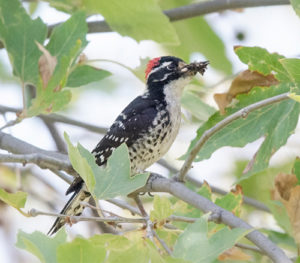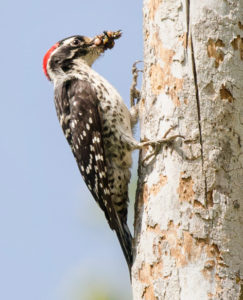Yummy, yummy bugs for my tummy!
It takes an unfailingly curious and persistent photographer like Peggy Honda to reveal the staggering number of bugs that woodpeckers capture, especially when raising a family. How many does it take?

Male Nuttall’s Woodpecker making a final visual check to ensure safety to enter nest cavity. Photo by Peggy Honda
There are too many variables to be sure, but when scientists have examined the stomachs of woodpeckers after death, between 500-950 insects have been found. Keep in mind stomachs have to be filled several times a day! In very cold temperatures when birds need greater caloric intake, that figure can leap into the thousands, especially when ants and beetle grubs are a big part of a species’ diet.
Apart from keeping themselves nourished, parent woodpeckers must spend several weeks each year making multiple trips per hour to deliver these juicy, protein-packed morsels to their demanding chicks. To carry one bug per trip would be as efficient as if we went to the market about 24 times a day for one grain of rice! So what actually enables parents to hold on to so many squirmy, crunchy groceries?
Though variations among species occur, generally speaking woodpeckers are equipped with long tongues coated with sticky saliva. A sensitive tongue-tip not only detects the presence of prey behind bark but becomes a bayonet. Tiny, backward-facing barbs at the edges act as spears suited for impaling insects. Furthermore, scientists have discovered that in the case of the Northern Flicker, its saliva is alkaline to counter the acidic defense of the ants.
But before we close this too-brief bulletin about woodpeckers, let’s consider for a moment the bug-buster service they provide. This family of birds not only helps to reduce pests that may damage trees, but by removing bark and exposing bugs for other insectivores, their pest control benefits are expanded. In doing so, they also keep the outdoors healthier and more comfortable for us!
One of the most critical things woodpeckers require from humans is an occasional dead tree in which to raise their family. Explore our website to learn how to select and safely retain these trees.



Connect
Connect with us on the following social media platforms.